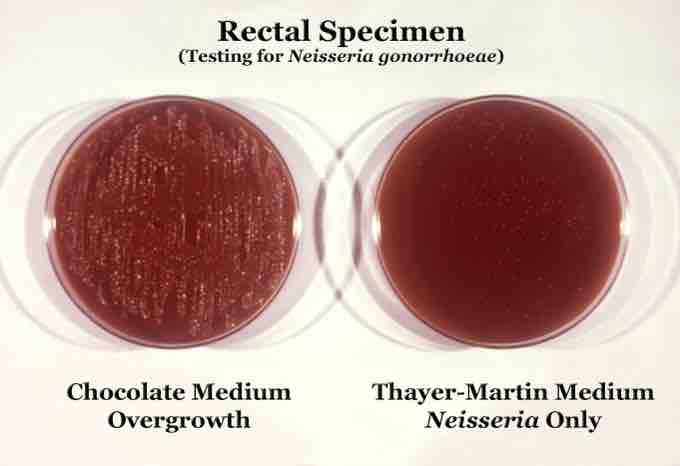There are many types of media used in the studies of microbes. Two types of media with similar implying names but very different functions, referred to as selective and differential media, are defined as follows.
Selective media are used for the growth of only selected microorganisms. For example, if a microorganism is resistant to a certain antibiotic, such as ampicillin or tetracycline, then that antibiotic can be added to the medium in order to prevent other cells, which do not possess the resistance, from growing . Media lacking an amino acid such as proline in conjunction with E. coli unable to synthesize it were commonly used by geneticists before the emergence of genomics to map bacterial chromosomes. Selective growth media are also used in cell culture to ensure the survival or proliferation of cells with certain properties, such as antibiotic resistance or the ability to synthesize a certain metabolite. Normally, the presence of a specific gene or an allele of a gene confers upon the cell the ability to grow in the selective medium. In such cases, the gene is termed a marker. Selective growth media for eukaryotic cells commonly contain neomycin to select cells that have been successfully transfected with a plasmid carrying the neomycin resistance gene as a marker. Gancyclovir is an exception to the rule as it is used to specifically kill cells that carry its respective marker, the Herpes simplex virus thymidine kinase (HSV TK). Some examples of selective media include:

Non-selective versus selective media.
The non-selective media on the right allows of the growth of several different bactarial species and is overgrown with bacteria (whitish lines). While the plate on the right selectively only allows the bacteria Neisseria gonorrhoeae, to grow (white dots).
- Eosin methylene blue (EMB) that contains methylene blue – toxic to Gram-positive bacteria, allowing only the growth of Gram negative bacteria.
- YM (yeast and mold) which has a low pH, deterring bacterial growth.
- MacConkey agar for Gram-negative bacteria.
- Hektoen enteric agar (HE) which is selective for Gram-negative bacteria.
- Mannitol salt agar (MSA) which is selective for Gram-positive bacteria and differential for mannitol.
- Terrific Broth (TB) is used with glycerol in cultivating recombinant strains of Escherichia coli.
- Xylose lysine desoxyscholate (XLD), which is selective for Gram-negative bacteria buffered charcoal yeast extract agar, which is selective for certain gram-negative bacteria, especially Legionella pneumophila.
Differential media or indicator media distinguish one microorganism type from another growing on the same media. This type of media uses the biochemical characteristics of a microorganism growing in the presence of specific nutrients or indicators (such as neutral red, phenol red, eosin y, or methylene blue) added to the medium to visibly indicate the defining characteristics of a microorganism. This type of media is used for the detection of microorganisms and by molecular biologists to detect recombinant strains of bacteria. Examples of differential media include:
- Blood agar (used in strep tests), which contains bovine heart blood that becomes transparent in the presence of hemolytic.
- Streptococcuseosin methylene blue (EMB), which is differential for lactose and sucrose fermentation.
- MacConkey (MCK), which is differential for lactose fermentationmannitol salt agar (MSA), which is differential for mannitol fermentation.
- X-gal plates, which are differential for lac operon mutants.